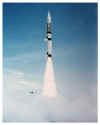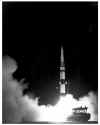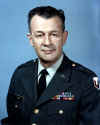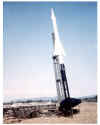1963
1963 MICOM first began delivering rocket launchers to the Republic of Vietnam, 2 years before American combat troops arrived.
January 63 AMC issued a directive stating that all customer service orders from non-AMC agencies, including the Advanced Research Projects Agency (ARPA); NASA; and DASA, would be accepted and programmed through the Materiel Command.
January 63 The United States Marine Corps (USMC) informed the Army that it was phasing out the HONEST JOHN system.
January 63 The TOW missile system development program was approved.

January to March 63 During this quarter, the AMC Aircraft Weaponization Project Office provided MICOM with funds for an in-house research and development project on a rocket weapon system for Army helicopters. Although the 40-mm rocket system (the MICOM-40) concept was not selected by the Aircraft Weaponization PM for advanced development, in May 64 the Ground Support Equipment Laboratory was instructed to plan user demonstrations with the system, which had been renamed the Missile Command Automatic Weapon (MICAW)
1 February 63 The ZEUS Project Office, which reported directly to AMC, became a Class II activity. However, it remained attached to MICOM for administration and to the AMSC for administration, logistical support, training, and administration of military justice.
25 March 63 Detachment A, MICOM, Patrick Air Force Base (AFB), Florida, was attached to Headquarters and Headquarters Detachment, AMSC for logistical supply, training, and administration of military justice, effective this date.
31 March 63 The first European CORPORAL battalions were deactivated.
15 April 63 MICOM discontinued the SHILLELAGH Commodity Office and the SHILLELAGH Branch of the Development Division of the Directorate of Research and Development after the functions of both organizations were transferred to WECOM on this date.

18 May 63 Actress Tallulah Bankhead dedicated an Army Ordnance Guided Missile School (OGMS) building memorializing her father, U.S. Representative William B. Bankhead and her uncle, U.S. Senator John H. Bankhead.

24 May 63 MICOM awarded a cost-plus-incentive-fee (CPIF) contract to Ling-Temco-Vought that was unique because it covered the entire research and development phase of the LANCE program. This was the first CPIF contract to be applied to an entire major Army weapon system, and the first to cover the complete development phase of an Army weapon system.
29 May 63 AMC directed that the SS-10 system be phased-out as the ENTAC system was fielded.
18 June 63 DA approved MICOM's proposed phase-out plan for the CORPORAL weapon system.
21 June 63 The Department of the Army (DA) approved MICOM's proposed phase-out plan for the REDSTONE weapon system. The Missile Command prepared a disposal brochure offering REDSTONE equipment to Department of Defense (DOD) agencies and other potential customers.

17 July 63 The LACROSSE Commodity Office, which had operated under the PERSHING Project Manager, was disbanded.
20 July 63 The first U.S. PERSHING I unit to be deployed overseas - the 4th Missile Battalion, 41st Artillery - made its official debut in organization day ceremonies at Fort Sill, Oklahoma. This unit became operational in June 64.


31 July 63 MICOM accorded exclusive recognition to Lodge 1858 of the American Federation of Government Employees (AFGE).
19 August 63 AMC assigned MICOM prime responsibility for air defense systems, which included both weapons and fire coordination.
24 August 63 MG Francis J. McMorrow, the MICOM Commander, died of a heart attack. He was the only sitting commander in RSA's history so far to die while on active duty. BG Howard P. Persons, Jr., assumed responsibility as Acting Commander from 15 August 63 until the appointment of a new commander.
16 September 63 AMC directed MICOM to conduct studies and tests on the feasibility of adapting the Navy's SIDEWINDER 1C air-to-air missile for surface-to-air use.
23 September 63 BG John G. Zierdt assumed command of MICOM.

25 October 63 DA approved the phase-out plan for the LACROSSE on this date and directed that all LACROSSE battalions and support units be inactivated as rapidly as possible.
November 63 Action regarding the Command Emergency Control Center was further described and more firmly established during this month. A control center previously set up during the Cuban missile crisis had been partially delineated in August 63. The November action assured MICOM's timely and effective control of emergencies. It also clearly identified the command's single point of contact with AMC Headquarters in emergencies requiring action by MICOM.
7 November 63 The Defense Supply Agency published a brochure prepared jointly by MICOM, MUCOM, and the Major Items Supply Management Agency (MISMA), which offered excess CORPORAL equipment to agencies within DOD as well as other potential customers.
8 November 63 William A. Davis, Jr. received the first MG Holger N. Toftoy award for his work in the field of laser technology. Presented by the American Institute of Aeronautics and Astronautics (AIAA), the Toftoy Award was established to supplement the Hermann Oberth and Martin Shilling awards presented by the AIAA in recognition of individual accomplishments.
December 63 Actual physical removal of NIKE AJAX missiles and related equipment from tactical sites in Europe began this month. By the end of FY 1964, all of the NIKE AJAX phase-out program had been completed for the European theater.

Excellence in Missilery:
Introduction,
1962,
1963,
1964,
1965,
1966,
1967,
1968,
1969,
1970,
1971,
1972,
1973,
1974,
1975,
1976,
1977,
1978,
1979
